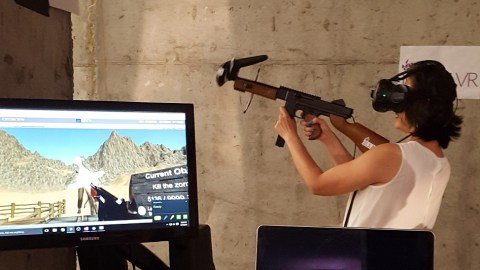Why Virtual Reality Games Will Be a Technological Revolution

Earlier this month I attended the Worlds Fair Nano in New York City. It was a festival devoted to the future of technology. The idea was lofty, and the festival’s talks and exhibits were were more tangential toward than supportive of that idea. But in the midst of social media discussions and drone demonstrations, I saw potential for a real innovation: a video game controller.
That controller is the one in the photo above. It’s a lightweight plastic gun that’s an exact replica of the one in the zombie game on the bottom left of the screen. The controller is made by Ilium VR, a startup that makes realistic controllers exclusively for virtual reality consoles, like the HTC Vive headset pictured above. This controller is an exact replica of the rifle in the demo zombie game in the display. It was the most popular exhibit at the event, with lines of people waiting 15 minutes to waste zombies for 60 seconds
Most of those people waiting to shoot zombies did not play shooting games or zombie games. Many of them were women. That’s impressive because only 48% of gamers are women, and few of them play shooting or zombie games:
Credit: Big Fish Games / YouTube
Virtual reality games have yet to catch on, but they’re getting there. Headsets like the Sega VR and Nintendo’s Virtual Boy have been around since the late 1980s, but the technology is finally coming into its own thanks to the Oculus Rift. The Rift is the result of an incredibly successful 2012 Kickstarter campaign. The technology allows gamers to move through immersive virtual environments like Tuscan villas, Arctic wilderness, and roller coasters. Those games were so successful that they inspired licensed virtual games like Alien: Isolation and Minecraft. They also inspired more virtual reality headsets like the HTC Vive, the Playstation VR, the VirtuSphere, and even the discontinued Google Cardboard.
Oculus Rift Headset. Credit: Oculus VR
Playthrough gif from Elite:Dangerous. Credit: Kotaku / Frontier Developments
Tuscan Villa from Tuscany Dive Google Cardboard Game. Credit: Fabulous Pixel
Alien: Isolation screenshot. Credit: Sega
For all that promise, there are still some limitations before virtual reality gaming embraces the mainstream. For starters the headsets cost hundreds of dollars, making them too expensive for most gamers. Developers are creating all kinds of virtual reality games, but Oculus’ parent company was acquired by Facebook and wants to use its technology for film rather than gaming, hampering the progress of the major player in the market. Until the technology becomes more accessible and the prices comes down, there won’t be an opportunity to test the tech with the consumer market.
That said, Ilium’s controller might help. I wasn’t able to wait in line to play the demo, but I did play with the controller. It was lightweight but a bit bulky for me (I’m petite; everything is too big for me). It made the prospect of playing a shooting game more intuitive to me. I appreciated that, since using a regular dual analog controller to play first-person shooter games is a bit prohibitive for me (figuring out what all the buttons do is fine; controlling the camera makes me crazy). I was encouraged by a controller that had almost no learning curve, and I felt confident about walking around a bunker to waste zombies.
Hopefully, controllers and other accessories like it will help ease other hesitant or even non-gamers into playing video games. The potential for immersive technology is too great to miss out on. Besides, I’d love for controllers like this to be offered in different sizes (I would like something I can actually hold, please!). I’m not sure when that will happen, but it will. I was sitting in a room full of eager young people who were just as inspired as me. I’m sure they’ll figure it out.
Credit: Laurie Vázquez / Worlds Fair Nano





